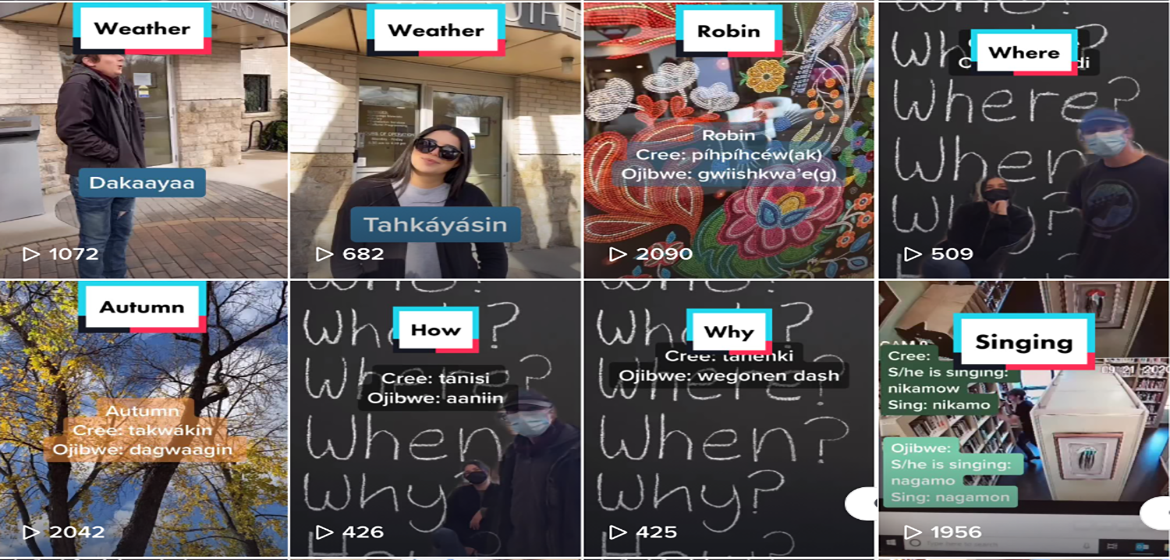Q&A with Tiktoker Sharissa Neault, promoting Indigenous languages online
Written by Rising Voices
As a child growing up in the Fox Lake Cree Nation in Northern Manitoba, Canada, Sharissa Neault would hear the Ininímowin (Cree) language from her grandparents. However, the language was not passed on her mother and consequently not to Neault either. “As I grew older, I heard less and less Ininímowin until I believed it was lost,” she would recount in an email interview with Rising Voices.
Fast forward to the present day, and Neault has moved to Winnipeg and has started working at the , a nonprofit educational organization that provides programs and services to help raise awareness of Indigenous cultures in the Province of Manitoba. This Canadian Province is located in Cree, Dakota, Dene, Ojibway, and Oji-Cree traditional First Nations territories, and the Métis Nation.
After she began working at the MICEC, Neault saw diverse ways to promote these languages, including social media. She joined forces with Noah Malazdrewicz, actively involved with sharing the Ojibwe language, and they begin creating TikTok videos on the Centre’s account (). Combining humor, everyday language use, and relatable situations, these videos are contributing to making the language accessible, especially during the ongoing pandemic when many people were at home. The results have been gratifying, as Neault shared with the of the University of Winnipeg, where she is currently studying:
“Young people are seeing it and saying “Thank you, I heard my granny say this as a kid,’ ‘I haven’t heard my language in years, thank you,’ or ‘I didn’t know I could still learn my language,’” Neault said. “The comments make it worth it.”

Photo provided by Sharissa Neault and used with permission.
In this short interview with Rising Voices she shares further information about herself, her language, and her digital activism:
Rising Voices (RV): What is the current status of your language both offline and on the internet?
Sharissa Neault (SN): There are 5 dialects of the Cree language, which also vary by community. My family speaks the n dialect (Swampy Cree), and my community’s dialect of Cree will die in the next 10-20 years with our last remaining fluent speakers. In other communities across Manitoba I would estimate that there are less that 500 fluent speakers under 50. When our older fluent speakers pass we will rely on these few young people, and their children to carry the language both online and offline. The n dialect is lacking in language learning resources, however, there are people who are working hard to create them alongside our remaining fluent speakers. The y dialect (Plains Cree) is in much better shape, with a higher number of speakers under 50, and many more online and offline resources.
RV: What have been the biggest challenges for you during your activities to promote your language and culture on the internet? And what are some of the ways that you have been trying to overcome these challenges?
SN: My biggest challenge has been finding the time to create content with other work commitments. I do my best to create content when I can, and in the past have created a collection of videos to post when I cannot record regularly.
RV: What are your main motivations for your language digital activism?
SN: My main motivations are the Indigenous youth who are just like me when I was 15. The Indigenous youth who think their culture and language are lost. I hope that when they see us, and hear us, they can see and hear themselves; I hope I can help at least one person who is like me, to pick up their language again.
RV: What are your hopes and dreams for your language?
SN: I hope that Ininímowin stays with us long enough for my grandchildren, or my great grandchildren, or my great-great grandchildren and so on, to learn the language as their first language, and understand the complex culture that is embedded in every word. That is all I hope for.
Source:
Related to SDG 10: Reduced inequalities



